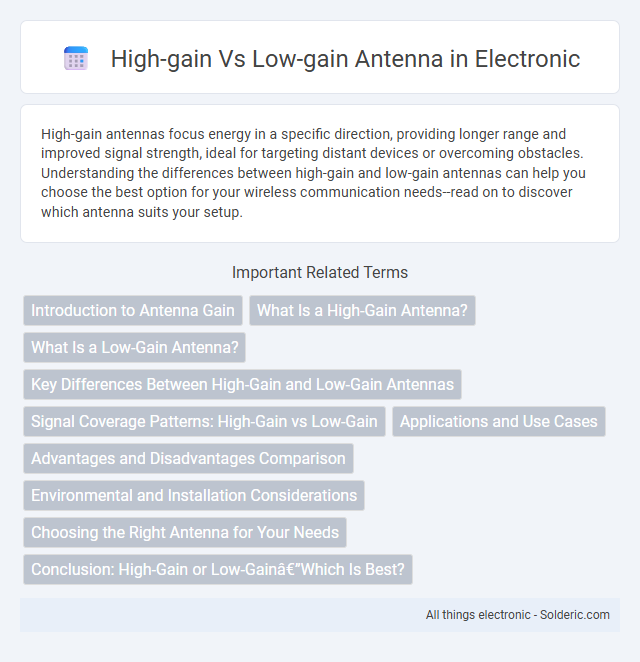High-gain antennas focus energy in a specific direction, providing longer range and improved signal strength, ideal for targeting distant devices or overcoming obstacles. Understanding the differences between high-gain and low-gain antennas can help you choose the best option for your wireless communication needs--read on to discover which antenna suits your setup.
Comparison Table
| Feature | High-Gain Antenna | Low-Gain Antenna |
|---|---|---|
| Gain | Typically 8 dBi or higher | Typically 0 to 5 dBi |
| Coverage Area | Narrow, focused beam | Wide, broad coverage |
| Range | Longer transmission range | Shorter transmission range |
| Directivity | Highly directional | Omnidirectional or less directional |
| Use Cases | Point-to-point communication, long-distance links | Wi-Fi routers, mobile devices, general coverage |
| Size | Generally larger and more complex | Smaller and simpler design |
| Signal Strength | Stronger in preferred direction | Weaker but covers multiple directions |
Introduction to Antenna Gain
Antenna gain measures how well an antenna directs radio frequency energy in a specific direction compared to an isotropic radiator, significantly impacting signal strength and coverage. High-gain antennas focus energy into narrower beams, enhancing long-distance communication and signal quality, whereas low-gain antennas disperse energy more widely for broader coverage with reduced range. Understanding antenna gain ratings in decibels (dBi or dBd) helps optimize antenna selection based on desired communication distance and coverage area.
What Is a High-Gain Antenna?
A high-gain antenna is designed to focus radio frequency energy in a specific direction, enhancing signal strength and increasing communication range. Its narrow radiation pattern concentrates power, making it ideal for long-distance transmissions and improving signal quality. Common types include parabolic dishes and Yagi antennas, which prioritize directional gain over wide coverage.
What Is a Low-Gain Antenna?
A low-gain antenna is designed to provide a wide coverage area with a broad radiation pattern, making it ideal for applications requiring omnidirectional signal distribution. Unlike high-gain antennas that focus energy in a specific direction to achieve longer range, low-gain antennas offer lower signal strength but enhance connectivity in multiple directions simultaneously. Your choice of a low-gain antenna benefits environments where consistent signal coverage across a large area is more critical than achieving maximum transmission distance.
Key Differences Between High-Gain and Low-Gain Antennas
High-gain antennas focus radio waves into a narrow beam, resulting in increased signal strength and longer transmission range, ideal for directional communication such as point-to-point links. Low-gain antennas emit signals over a wider angle, providing broader coverage but shorter range, making them suitable for applications like Wi-Fi routers and mobile devices. The main differences lie in radiation pattern, signal range, and application use cases, with high-gain antennas offering precision and distance while low-gain antennas prioritize coverage area.
Signal Coverage Patterns: High-Gain vs Low-Gain
High-gain antennas focus signal strength into a narrow, concentrated beam, resulting in extended range and improved signal quality in specific directions, ideal for point-to-point communication. Low-gain antennas distribute signals more evenly in a wider pattern, providing broader coverage but with reduced distance and signal intensity. Your choice between high-gain and low-gain antennas depends on whether you need focused long-distance coverage or wide-area reception.
Applications and Use Cases
High-gain antennas are ideal for long-distance communication, such as satellite links, radar systems, and point-to-point wireless networks, where focused signal strength is crucial. Low-gain antennas suit applications requiring wide coverage and omnidirectional reception, including Wi-Fi routers, mobile devices, and broadcasting systems. Your choice depends on whether you prioritize signal range and directionality or broad area coverage.
Advantages and Disadvantages Comparison
High-gain antennas offer increased signal strength and extended range, making them ideal for long-distance communication, but they have narrower coverage areas and can be more susceptible to interference. Low-gain antennas provide wider coverage and better performance in multi-directional environments, though their signal strength and range are limited compared to high-gain models. Your choice depends on the specific application requirements, balancing the need for range versus coverage area.
Environmental and Installation Considerations
High-gain antennas, designed for long-distance signal transmission, require precise alignment and clear line-of-sight, making them best suited for open environments with minimal obstructions. Low-gain antennas provide broader coverage with less directionality, ideal for areas with obstacles or where installation flexibility is necessary. Your choice between high-gain and low-gain antennas should consider the surrounding environment and mounting options to ensure optimal signal performance.
Choosing the Right Antenna for Your Needs
High-gain antennas provide focused, long-range signal transmission ideal for extending coverage in specific directions, while low-gain antennas offer broader, more uniform coverage suitable for local area connectivity. When choosing the right antenna for your needs, consider factors like the desired signal range, coverage area shape, and environment interference. Your decision should balance gain with application requirements to optimize signal strength and network performance.
Conclusion: High-Gain or Low-Gain—Which Is Best?
High-gain antennas provide focused signal strength ideal for long-distance communication, while low-gain antennas offer broader coverage suitable for short-range or multipath environments. The choice depends on specific application requirements such as range, coverage area, and signal quality. For fixed, directional links, high-gain antennas are optimal, whereas low-gain antennas excel in mobile or omni-directional scenarios.
high-gain vs low-gain antenna Infographic

 solderic.com
solderic.com